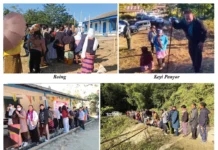[Genom Tekseng]
The proposed Siang upper multipurpose project (SUMP) has become a hot topic of debate in Arunachal Pradesh, particularly among the Adi community. This large-scale project, proposed by the government of India, aims to store 9.2 billion cubic metres (bcm) of water in the Siang river. The goal is to safeguard the region from the potentially devastating impacts of the Medog dam being constructed by China upstream of the Siang (YarlungTsangpo) river. However, as with the large infrastructure project, there are mixed reactions from local communities. While some see it as a necessary measure vis-à-vis water security, flood management, strategic pre-emption and economic development, others fear it could threaten their way of life and lead to forced displacement. To understand the complexities surrounding this project, it is necessary to know the background and potential benefits and drawbacks.
Why is SUMP needed?
The primary motivation for the SUMP stems from concerns about the Medog dam in Tibet (China), which is expected to have a storage capacity of 5.5 bcm that can generate a hydroelectric power potential of 60,000 mw from a natural elevation height that provides hydraulic head above 1,500 metres. There is growing fear that China may divert the flow of the Siang river into its territory, drastically affecting the water supply downstream in Arunachal Pradesh, Assam, and Bangladesh. According to data from the Central Water Commission (CWC), 86% of the Siang river’s water originates from China during the winter months (November to April). A diversion of this water would lead to a drastic reduction in the river’s flow, potentially drying up the river during winter and causing erratic flood-like conditions at other times. There shall be constant fear by the downstream riparian areas from the proposed Medog dam,whether the water from the river is diverted or not. To counter any eventuality from this large-scale project and to regulate the environmental flow of the Siang river, ensuring the health of the river ecosystem, the government of India proposed a project having a water storage capacity of 9.2 bcm on the Siang river and generating about 11,000 mw of hydroelectric power from a pondage height of about 280 metres.
How will it impact India?
The construction of the China dam would not only empower China to control the river’s water flow but also pose the risk of flooding border areas by releasing large volumes of water during potential hostilities due to its sheer size and scale.
In such a scenario, the SUMP would play a crucial role by ensuring a steady water supply, moderating floods, and helping manage the flow of water in the region. The project would also provide much-needed infrastructure and economic benefits to Arunachal, and Assam will be relieved from damages due to devastating flashfloods every year triggered by the proposed Medog dam in China.
The local perspective: Apprehensions and misconceptions
For the local Adi community, which predominantly resides in Siang and Upper Siang districts, the project represents both an opportunity and a threat. Traditionally, the Adi people relied on shifting cultivation (jhum), hunting, and fishing for their livelihoods. Over time, wet rice cultivation (WRC) and horticulture, especially the cultivation of oranges, pineapples, and other cash crops, have become mainstay cash crops in the region. Many Adi families feel proud of their WRC land, which is viewed as a symbol of prosperity.
However, the proposed SUMP threatens to submerge large portions of the land that many Adi people depend on for their agricultural activities. There is widespread fear that the project will render them landless and force them into displacement. Additionally, there are concerns about the influx of outsiders and the potential disruption of local customs and traditions. These fears are often exacerbated by anti-dam activists and people with vested interests who misinform the villagers, claiming that the dam would lead to their displacement without fair compensation or rehabilitation. However, it is immature to ascertain the land to be submerged and villages to submerged and displaced due to the project without conducting PFR.
It is also important to note that many local villagers, although not necessarily opposed to the project, remain silent due to fear of social ostracism or physical threats from anti-dam groups. This atmosphere of fear and misinformation has made it difficult for the local population to fully understand the potential benefits of the SUMP and engage in constructive discussions.
Brief of resettlement, rehabilitation
There have been concerns among the public regarding the resettlement and rehabilitation of displaced people and compensation due to the upcoming project. Generally, in a hydropower project, the displacement will not occur immediately once the project starts. After the pre-feasibility Report (PFR) is prepared, it will take approximately 2-3 years to complete the detailed project report (DPR). During this phase, all necessary procedures, such as environmental clearances, public hearings, and land acquisition, will be carried out.
The construction of the project will start after all clearances are obtained and land compensation is paid, including the public hearing. The construction period of the project may span over 10 years or more. Actual displacement will only take place after the project is completed. Before displacement, the developer will provide adequate notice to affected landowners and displaced people. The landowners will have the opportunity to use the compensation money and any compensated land during the construction phase. The resettlement and rehabilitation process will be done during the construction phase.
The role of outsiders and political influence
There is no denying that outsiders play a significant role in shaping the public opinion surrounding the SUMP. Many self-styled activists, political opportunists, and organisations have been quick to exploit the situation for their own benefit. They often present a distorted view of the project’s impact, misguiding the local people with promises of development that are unlikely to materialise. These groups with vested interest often capitalise on the innocence and lack of awareness among the local population, feeding their fears and creating divisions within the community.
It is essential for the people of Adi community to resist the influence of these external forces and evaluate the project based on its merits and potential benefits, rather than on the distorted narratives spread by vested interests.
The potential benefits of SUMP
Despite the apprehensions of the local population, there are compelling reasons to support the construction of the SUMP, for the Adi community, Arunachal, and the Northeastern states as a whole. The project promises a range of benefits, including:
Water security: The SUMP will ensure a steady water supply for the region, especially in times of water scarcity caused by upstream activities in China. The dam will act as a buffer, storing water during the monsoon season and releasing it during dry periods, thereby ensuring reliable water availability for agriculture and drinking.
Flood mitigation: The dam will store excess water during heavy rainfall, preventing downstream flooding in flood-prone areas like Pasighat and other parts of Assam. It will also regulate seasonal water flow, reducing the risk of flashfloods caused by sudden upstream water releases.
Hydropower generation: The SUMP has the potential to generate 11,000 mw of power, providing clean, renewable energy to the Northeastern states, which have long struggled with energy shortages. This will stimulate local economic development and improve infrastructure, such as roads, bridges, and communication networks.
Strategic importance: The dam will serve as a strategic countermeasure to China’s growing influence over the Siang river. By controlling the water flow within its own territory, India will be able to mitigate the impacts of China’s upstream activities, maintaining leverage over the river’s management.
Agricultural benefits: By ensuring a steady water supply and regulating the water table, the SUMP will enhance agricultural productivity in the region, which relies heavily on irrigation from the Siang and the Brahmaputra rivers. It will also help preserve the fertile floodplains of Assam, which are vital for local agriculture.
Economic and regional development: The construction of the SUMP will create jobs, boost local industries, and improve infrastructure in a region that is currently underdeveloped. The dam’s reservoir and associated infrastructure will also attract investment and tourism, further contributing to the region’s economic growth.
Environmental considerations: The SUMP will help regulate the environmental flow of the Siang river, ensuring the health of the river ecosystem. The dam will trap sediments that could otherwise harm downstream agriculture and ecosystems, helping preserve the region’s fragile environment.
Counteracting water weaponisation of China: In the event of hostility, there is a risk that China could utilise these dams to create artificial floods, endanger downstream communities, and disrupt vital river systems. A dam on the Siang river would give India a strategic foothold over its own water resources, ensuring that such actions do not affect the country’s Northeastern states
GoAP’s commitment to the welfare of project-affected people
The state government has taken proactive steps to engage with and sensitise the people affected by the upcoming project. With a deep understanding of the socioeconomic importance of the project for both the local populace and the nation at large, the government is fully committed to ensuring that the rights, interests, and wellbeing of those impacted are protected.
The district administration, through local panchayats, gaon burahs, CBOs and public leaders, are actively working to inform and involve the project-affected communities. The project-affected people have also been sensitised to the merit and demerit of the project through a variety of initiatives, including exposure tours, seminars, public meetings, and village outreach programmes. These efforts are designed to provide the affected communities with the necessary information, address concerns, and ensure transparency at every stage of the project.
The government of India has also pledged its support, confirming that generous compensation and relief and rehabilitation packages will be made available, and crafted in consultation with the people directly impacted by the project. This ensures that the rehabilitation process is carried out with due sensitivity to the needs and wishes of the project-affected families.
One of the most crucial aspects of the rehabilitation plan is the relocation of the affected people to safer areas, well above the projected inundated zones. The state government has assured that these relocation sites will be equipped with modern infrastructure, ensuring that the resettled communities will have access to essential services and a high standard of living. Moreover, the government is open to suggestions from the affected people regarding their relocation preferences, giving them a voice in the decision-making process.
The state government believes that the long-term success of this project depends not only on its economic and infrastructural benefits but also on the care and support provided to the people whose lives may be impacted. By working closely with local leaders, communities, and experts, the government aims to create a model of development that is both inclusive and sustainable.
The government remains committed to keeping the public informed and engaged, ensuring that no one is left behind. This initiative reflects the government’s unwavering dedication to the welfare of the people of the state and the larger goal of national development
With the offers of numerous benefits of the project, the state government is proposing to implement the project in a way that minimises the negative impact on the local community. This means ensuring that the people who will be affected by the project are adequately compensated and rehabilitated. The state government has constituted a Siang Upper Multipurpose Project Development Committee (SUMPDC) to hold extensive consultations with all project-affected families, to understand, appreciate and address their concerns etc, to implement the project transparently, and also to ensure that they are fully informed about the potential outcomes of the project.
Though the SUMP has challenges from some sections of society, it offers opportunities for water security, flood moderation, strategic importance and economic growth project affected areas and the entire Northeastern region with careful planning, transparent communication and implementation of the project. The successful implementation of the project can be a blessing in disguise for the Adi community, Arunachal, and the country as a whole. (The writer is a resident of Simong village, Yingkiong, Upper Siang district.)



